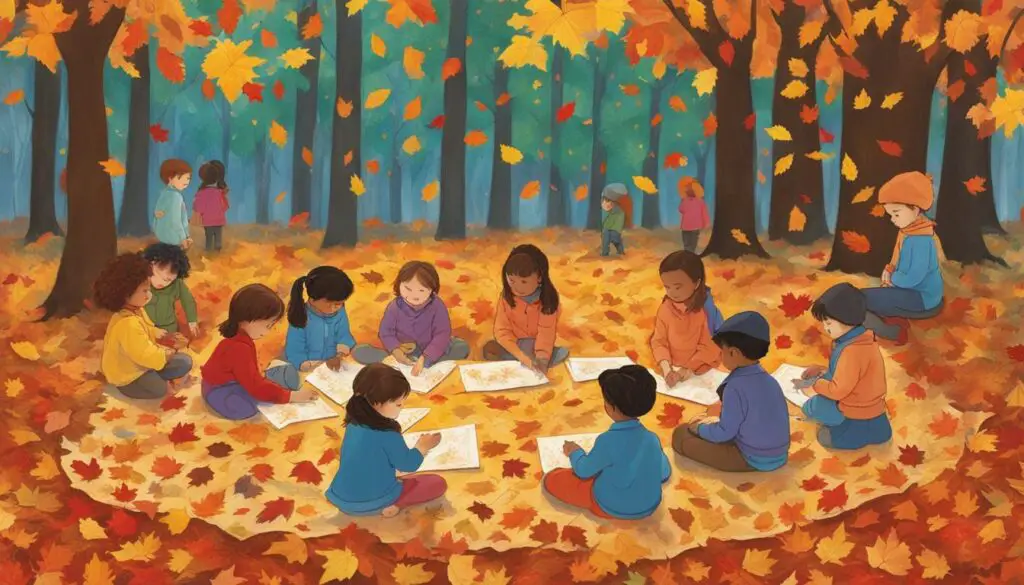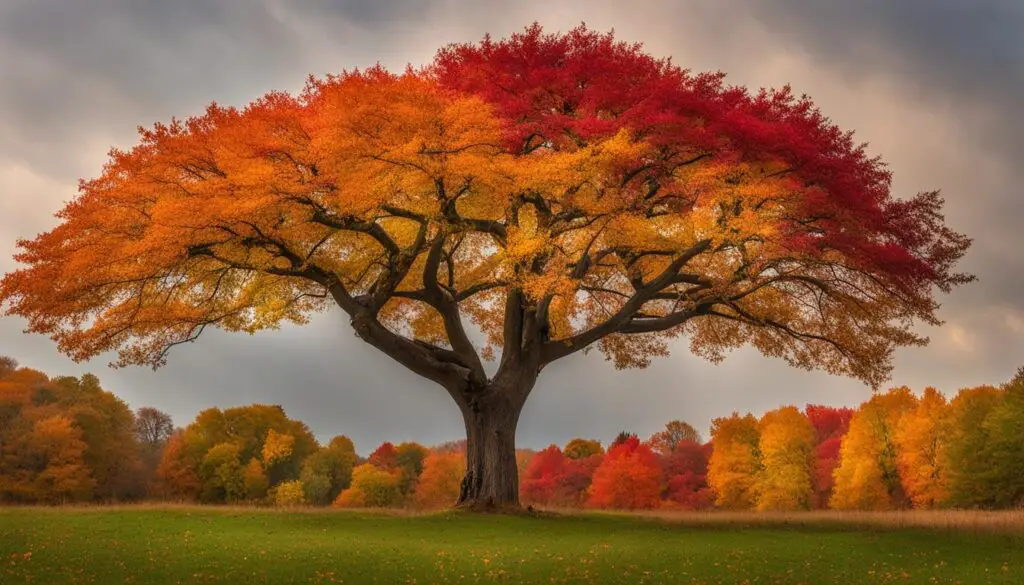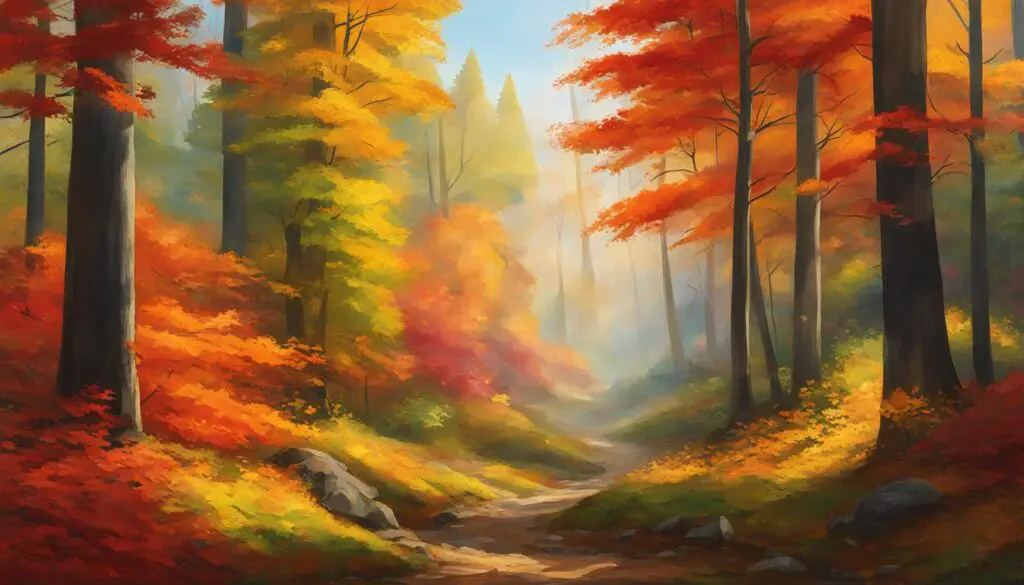As the seasons transition from summer to fall, there is a magical transformation that takes place in nature. The lush green leaves that once adorned the trees begin to undergo a stunning metamorphosis, painting the landscape with vibrant hues of red, orange, and gold. But have you ever wondered why trees change color in autumn?
The phenomenon of leaves changing colors is a fascinating sight, and it has captured the curiosity of scientists and nature enthusiasts alike. In this article, we will uncover the science behind this seasonal transformation and explore the environmental factors that influence the color change in tree foliage.
Key Takeaways:
- Leaves changing colors in the fall is a result of the breakdown of chlorophyll, the pigment responsible for the green color in leaves.
- Environmental factors such as temperature, light levels, and moisture can impact the duration and vibrancy of autumn colors.
- Deciduous trees are the ones that undergo a color change in the fall, while evergreen trees retain their green color year-round.
- The timing of color change varies depending on genetic factors and environmental cues.
- The annual leaf drop in deciduous trees serves important purposes in the ecosystem, contributing nutrients to the soil and providing habitat for wildlife.
The Science Behind Changing Colors
The process of leaves changing colors in the fall is a fascinating phenomenon rooted in the science of trees. It all begins with photosynthesis, the process by which trees convert sunlight, water, and carbon dioxide into glucose and oxygen. During photosynthesis, chlorophyll, the green pigment in leaves, plays a crucial role in absorbing light energy to facilitate the production of glucose.
As autumn approaches and the days get shorter, trees start to prepare for winter. They detect environmental cues such as decreasing light levels and cooler temperatures. In response, the production of chlorophyll begins to decline, leading to its breakdown and subsequent disappearance from the leaves.
With the breakdown of chlorophyll, other pigments that have been present in the leaves all along become more visible. These pigments, such as anthocyanins and carotenoids, give rise to the vibrant red, orange, and yellow hues that paint the autumn scenery.
Anthocyanins are responsible for the red and purple colors seen in leaves, while carotenoids contribute to the orange and yellow tones. These pigments are usually present in lower concentrations during the growing season, masked by the dominance of chlorophyll. However, as chlorophyll breaks down, these pigments are unmasked and become more pronounced, leading to the stunning display of fall foliage.
The Breakdown of Chlorophyll: A Delicate Balance
The breakdown of chlorophyll is a delicate balance influenced by environmental factors such as temperature, light, and moisture. Cooler temperatures and shorter days trigger the production of enzymes that facilitate chlorophyll breakdown. However, extreme heat or drought conditions during the growing season can accelerate the degradation of chlorophyll, leading to premature leaf drop rather than a gradual color change.
The Role of Carotenoids
Carotenoids, the pigments responsible for the orange and yellow colors in leaves, play an important role in photosynthesis. They help protect the chlorophyll from damage caused by excess light energy, ensuring that the process continues efficiently. During the fall, as chlorophyll levels wane, carotenoids take center stage, captivating our eyes with their warm and vibrant hues.
Understanding the science behind the changing colors of leaves adds a layer of appreciation to the beauty of autumn. It highlights the intricate balance of nature and the remarkable adaptations trees undergo to survive and thrive through the seasons.
Environmental Factors Affecting Leaf Color
The timing and intensity of fall foliage can be influenced by various environmental factors. Changes in temperature, light levels, and moisture can all impact the duration and vibrancy of autumn colors. Additionally, factors such as soil conditions and tree health can also play a role in the color change process.
Temperature: As the days become shorter and temperatures start to cool in the fall, trees respond by preparing for winter. This triggers a reduction in chlorophyll production and exposes other pigments, resulting in the vibrant hues of autumn leaves.
Light Levels: Decreased sunlight during the fall season contributes to the breakdown of chlorophyll and the onset of color change. Changes in light intensity and duration can influence the timing and intensity of leaf coloration.
Moisture: Adequate moisture in the soil is essential for the overall health of trees and can affect the quality of fall foliage. Drought conditions may lead to premature leaf drop or less vibrant colors, while optimal moisture levels contribute to robust and colorful autumn displays.
Soil Conditions: The availability of nutrients in the soil can impact the health and vitality of trees, which in turn affects the color change process. Nutrient-rich soil can promote vibrant leaf colors, while nutrient deficiencies may result in dull or faded hues.
Tree Health: The overall health and vitality of a tree can influence the intensity and duration of fall foliage. Trees that are stressed or diseased may exhibit less vibrant colors or experience early leaf drop.

Understanding the environmental factors that affect leaf color can deepen our appreciation for the intricate processes at work in nature. By considering the interplay between temperature, light, moisture, soil conditions, and tree health, we gain insight into the stunning displays of autumn foliage that captivate us each fall.
Types of Trees That Undergo Color Change
When it comes to the vibrant fall foliage that dazzles us each year, it’s important to understand which types of trees undergo a color change.
Deciduous trees are the primary players in this stunning transformation. These trees include species like maples, oaks, and aspens. Deciduous trees shed their leaves annually as they prepare for winter. This shedding process allows them to conserve energy and protect themselves against the colder temperatures.
Evergreen trees, on the other hand, do not experience a significant change in color during the fall season. These trees, such as pines and spruces, retain their needles year-round. Their foliage remains green throughout the year, providing a constant splash of color in both summer and winter.
Understanding the difference between deciduous trees and evergreens is vital for appreciating the beauty and diversity of autumn’s color palette.
A Comparison of Deciduous Trees and Evergreens
| Deciduous Trees | Evergreen Trees |
|---|---|
| Shed their leaves annually | Retain their needles year-round |
| Undergo a significant color change in the fall | Experience minimal color change |
| Include species like maples, oaks, and aspens | Comprise trees like pines and spruces |
Image:
The Timing of Color Change
The timing of color change in trees is influenced by a combination of genetic factors and environmental cues. Different tree species exhibit varying patterns and timelines for their fall foliage transformation. Some trees may start changing colors as early as late summer, while others hold onto their leaves longer than their counterparts.
Genetics play a crucial role in determining when a tree will undergo its color change. Each tree species has its own genetic programming that dictates its response to seasonal changes. This programming influences when the tree will begin the process of “turning” its leaves.
Environmental cues also play a significant role in the timing of color change. Trees are highly attuned to their surroundings, and they rely on external factors to activate the processes involved in leaf color transformation. Changes in temperature and light levels, as well as the availability of water and nutrients, act as signals for trees to prepare for winter and shed their leaves. These environmental cues trigger a cascade of physiological changes leading to the breakdown of chlorophyll and the synthesis of other pigments that give rise to the vibrant fall colors.
Notably, trees of the same species living in similar latitudes tend to change colors at the same time, regardless of elevation. This suggests that the timing of color change is primarily influenced by the length of daylight and temperature patterns associated with specific latitudes.
To visually depict the variety in timing of color change, the table below outlines the color change timeline for selected tree species:
| Tree Species | Timing of Color Change |
|---|---|
| Maple | Early to Mid-October |
| Poplar | Mid to Late-October |
| Oak | Mid-October to Early November |
| Birch | Late-September to Early October |
Understanding the timing of color change in trees helps us appreciate the intricate interplay between genetics and environmental cues. It allows us to witness and celebrate nature’s remarkable ability to adapt and transition with the changing seasons.

The Benefits of Leaf Drop
The annual leaf drop in deciduous trees provides valuable ecosystem services. As leaves naturally fall from the trees, they contribute essential nutrients to the soil, enriching it for future plant growth. This nutrient cycling process plays a vital role in sustaining a healthy ecosystem.
Additionally, fallen leaves create a habitat for various forms of wildlife. Small animals, insects, and microorganisms can find shelter and food among the decomposing leaves. This promotes biodiversity and supports the delicate balance of the ecosystem.
Moreover, the layer of fallen leaves on the ground acts as insulation for tree roots during the cold winter months. It helps to protect the roots from freezing temperatures, reducing the risk of damage.
Overall, the process of leaf drop not only beautifies the autumn landscape but also provides essential ecosystem services, including nutrient recycling, habitat creation, and root protection.
The Benefits of Leaf Drop
| Ecosystem Services | Benefits |
|---|---|
| Nutrient recycling | Contribution of essential nutrients to the soil, enriching it for future plant growth |
| Habitat creation | Provides shelter and food for wildlife, supporting biodiversity |
| Root protection | Insulates tree roots from freezing temperatures during winter |
Leaf Rubbing Activity
Engaging in leaf rubbing activities is a fantastic way to combine art and science while exploring the diverse colors and textures of leaves. This hands-on activity allows children to observe and identify different types of leaves, while also creating beautiful leaf rubbings that showcase the intricate details of nature.
Leaf rubbing, also known as leaf etching or leaf printing, involves placing a leaf, vein-side up, underneath a piece of paper. Using a crayon or pencil, gently rub over the paper to transfer the shape and texture of the leaf onto the surface. The result is a unique artwork that captures the essence of the leaf.
Through leaf rubbing, children can develop their fine motor skills and observational abilities. They learn to appreciate the intricate patterns and textures found in various leaves, while also discovering the different colors that nature has to offer.
“Leaf rubbing is a wonderful activity that encourages children to explore the natural world and engage their senses. It provides an opportunity to foster creativity, curiosity, and appreciation for the beauty of nature.”
Leaf rubbing activities can be done individually or as a group, making it a great choice for classrooms, nature clubs, or family outings. It can be adapted to different age groups and skill levels, allowing everyone to participate and express their creativity.
To get started with leaf rubbing, you’ll need the following materials:
- Leaves in various shapes, sizes, and colors
- Plain white paper or lightweight cardstock
- Crayons or colored pencils
- Tape or adhesive putty to secure the leaf in place
Here are a few tips for a successful leaf rubbing experience:
- Collect a variety of leaves from different trees or plants. Look for leaves with interesting shapes, textures, and colors.
- Place the leaf on a flat, smooth surface. Position the paper on top of the leaf and secure it in place using tape or adhesive putty.
- Choose a crayon or colored pencil in a contrasting color to the leaf. Hold it at a slight angle and gently rub it over the paper, following the contours of the leaf.
- Experiment with different pressures and angles to achieve varying levels of detail and shading in your leaf rubbing.
- Try combining different leaves or overlapping them to create unique compositions and patterns.
Once you’ve finished rubbing the leaf, carefully remove it from the paper to reveal your beautiful leaf imprint. You can further enhance your artwork by adding additional details or colors using markers or watercolors.
Leaf rubbing activities not only provide a creative outlet but also encourage children to explore the natural world, learn about different types of trees and plants, and develop an appreciation for the beauty and diversity of leaves.

Common Leaves for Leaf Rubbing
| Name of Leaf | Color | Leaf Shape | Texture |
|---|---|---|---|
| Maple | Red, Orange, Yellow | Palmate | Smooth or Veined |
| Oak | Brown, Yellow | Variable, Lobed | Veined |
| Birch | White, Yellow | Oval or Triangular | Smooth |
| Sycamore | Yellow, Brown | Hand-like | Veined |
| Aspen | Golden Yellow | Rounded, Heart-shaped | Smooth or Rustling |
Using Chromatography to Predict Leaf Colors
If you’ve ever wondered how the beautiful colors of autumn leaves are determined, chromatography can provide some insight. This scientific technique allows us to predict the colors that leaves will turn in the fall by separating the pigments present in the leaves.
To conduct a simple chromatography experiment, you’ll need torn leaves from different trees, glasses of rubbing alcohol, and strips of coffee filters. Begin by placing the torn leaves into the glasses of rubbing alcohol and allowing them to soak for a few hours. Then, gently remove the leaves and lay them on the strips of coffee filters. As the rubbing alcohol evaporates, it will carry the pigments with it, causing the colors to separate and form distinct bands on the coffee filter strips.
This experiment can be particularly engaging for children, as it allows them to observe firsthand how different pigments contribute to the vibrant hues of autumn foliage. By analyzing the separated pigments, they can make predictions about the colors that leaves will display in the fall.
The Role of Chlorophyll in Leaf Color
The green color of leaves is attributed to the presence of chlorophyll, which plays a vital role in leaf color. Chlorophyll is the pigment responsible for photosynthesis, the process by which plants convert sunlight into energy and produce food for their growth and development.

During the fall season, as the days get shorter and temperatures begin to cool, trees undergo changes in their physiological processes. One significant change is the decrease in chlorophyll production. As a result, the green pigment gradually breaks down, revealing other pigments that were previously masked by the dominant presence of chlorophyll.
This transformation allows the vibrant array of colors seen in autumn leaves to emerge. Pigments such as anthocyanins, which produce hues of red and purple, and carotenoids, responsible for orange and yellow shades, become more visible and contribute to the stunning fall foliage.
Fall Foliage Hotspots
When it comes to experiencing the breathtaking beauty of fall foliage, there are several hotspots across the United States that never disappoint. From the vibrant reds of Colorado to the stunning yellows of Vermont and the fiery oranges of Massachusetts, these regions are renowned for their spectacular displays of autumn colors.
Colorado, with its diverse landscapes, offers a kaleidoscope of colors during the fall season. The mountains and national parks in this state are adorned with mesmerizing hues, creating a picturesque backdrop for nature enthusiasts and photographers alike.
Vermont, often referred to as the “Green Mountain State,” transforms into a stunning panorama of red, orange, and gold each autumn. The scenic drives through the countryside and picturesque towns provide an incredible opportunity to witness nature’s magnificent display.
Massachusetts, particularly the Berkshire Mountains and the Cape Cod region, is another hot spot for fall foliage enthusiasts. As the leaves change color, the landscapes become a patchwork of vibrant oranges, fiery reds, and golden yellows, adding a touch of magic to the charming towns and coastal areas.
From coast to coast, there are countless destinations where leaf peepers can immerse themselves in the beauty of autumn. Whether it’s exploring the Great Smoky Mountains in North Carolina, witnessing the golden aspens in Colorado’s Rocky Mountains, or meandering along the scenic byways of New Hampshire, each location offers a unique and unforgettable fall foliage experience.
Savoring the vibrant colors of fall foliage is a cherished tradition for many. Whether you embark on a road trip, hike through nature trails, or simply relax and admire the view, these fall foliage hotspots promise a visual feast that will leave you in awe of the wonders of nature.
The Beauty and Significance of Fall Colors
The breathtaking beauty of fall colors captivates people each year, drawing them outdoors to witness nature’s awe-inspiring display. The vibrant hues of autumn foliage, ranging from fiery reds to golden yellows and burnt oranges, create a visual spectacle that is both mesmerizing and enchanting. As the leaves change and blanket the ground, the landscape transforms into a picturesque canvas, mesmerizing all who behold it.
But fall colors are not only visually appealing; they also hold great significance in the natural world. The transition from lush, green leaves to the vibrant tapestry of autumn serves as a signal of seasonal change. It is a reminder that nature is in constant motion, shifting and adapting to the rhythm of the seasons.
For trees, the process of changing colors is a mechanism for survival. As temperatures drop and daylight hours shorten, deciduous trees prepare themselves for the harsh winter ahead. They redirect energy away from leaf production and prepare for dormancy. This redirection of resources triggers a breakdown of chlorophyll, the pigment responsible for the green color in leaves, allowing other pigments, such as carotenoids and anthocyanins, to become visible.
“The vibrant hues of autumn foliage, ranging from fiery reds to golden yellows and burnt oranges, create a visual spectacle that is both mesmerizing and enchanting.”
Carotenoids, responsible for the warm hues of yellow and orange, are present in leaves throughout the year but are masked by the dominant green chlorophyll during the growing season. Anthocyanins, on the other hand, are produced in response to changing environmental conditions and are responsible for the vibrant reds and purples seen in some tree species.
Apart from their aesthetic beauty, fall colors serve important ecological functions. As leaves fall to the ground and decompose, they enrich the soil with vital nutrients, replenishing the earth for future plant growth. This process contributes to the overall health and vitality of the ecosystem. Additionally, fallen leaves provide habitat and food sources for various organisms, supporting biodiversity and creating a thriving environment for insects, birds, and small animals.
As we marvel at the beauty of fall colors, we are reminded of the intricate and interconnected web of life that exists in nature. The changing of seasons signals the cycle of life, death, and rebirth, highlighting the resilience and adaptability of the natural world. It is a time of reflection and appreciation for the wonders of the earth, as we witness nature’s artistry unfold before our eyes.

Conclusion
In conclusion, the changing colors of leaves in the fall are a captivating and enchanting natural phenomenon. This breathtaking spectacle is the result of a delicate interplay between biological processes and environmental factors. Through understanding the science behind this seasonal transformation, we can gain a deeper appreciation for the wonders of nature and cultivate a sense of wonder and curiosity about the world around us.
The breakdown of chlorophyll and the emergence of other pigments in leaves create the vibrant array of colors that adorn trees during autumn. Environmental cues, such as temperature and light levels, further influence the timing and intensity of fall foliage. Trees shed their leaves, providing vital nutrients to the soil, offering habitat for wildlife, and helping tree roots withstand the winter months.
Witnessing the beauty of fall colors is an experience that awakens our senses and connects us to the rhythm of the natural world. As we marvel at the stunning reds, oranges, and yellows, let us not forget the ecological significance of this seasonal transformation. The changing colors of leaves in the fall remind us of the cyclical nature of life and the beauty that can be found in transitions.
FAQ
Why do trees change color in the fall?
The process of leaves changing colors in the fall is due to the breakdown of chlorophyll, the pigment responsible for the green color in leaves. As the days get shorter and temperatures cool, trees pick up on cues from their environment and begin to prepare for winter. This triggers a reduction in chlorophyll production, allowing other pigments, such as anthocyanins (red and purple hues) and carotenoids (orange and yellow hues), to become more visible in the leaves.
What environmental factors affect the color change of leaves?
The timing and intensity of fall foliage can be influenced by various environmental factors. Changes in temperature, light levels, and moisture can all impact the duration and vibrancy of autumn colors. Additionally, factors such as soil conditions and tree health can also play a role in the color change process.
What types of trees undergo color changes in the fall?
Deciduous trees, which include species like maples, oaks, and aspens, are the ones that undergo a color change in the fall. These trees shed their leaves annually as they prepare for winter. On the other hand, evergreen trees, like pines and spruces, retain their needles year-round and do not experience a significant change in color during the fall season.
When does the color change happen in trees?
The timing of color change in trees can vary depending on genetic factors and environmental cues. Some species may start changing colors as early as late summer, while others may retain their leaves longer than others. Interestingly, trees of the same species living at similar latitudes tend to change colors at the same time, regardless of elevation.
What are the benefits of leaf drop in deciduous trees?
The annual leaf drop in deciduous trees serves important purposes in the ecosystem. As leaves decompose, they contribute nutrients to the soil, helping to enrich it for future plant growth. Additionally, fallen leaves can provide habitat for wildlife and help insulate tree roots during the winter months.
What is a leaf rubbing activity?
Engaging in leaf rubbing activities can be a fun and educational way to explore the different colors and textures of leaves. This art and science activity allows children to observe and identify leaves while creating beautiful leaf rubbings. It can also be a great way to spark curiosity and appreciation for the natural world.
How can chromatography be used to predict leaf colors?
Chromatography can be used as a scientific technique to predict the colors that leaves will turn in the fall. By placing torn leaves into glasses of rubbing alcohol and adding strips of coffee filters, the pigments in the leaves can separate and reveal different bands of color. This experiment can help children understand how different pigments contribute to the vibrant hues of autumn foliage.
What is the role of chlorophyll in leaf color?
The green color of leaves is attributed to the presence of chlorophyll, which is responsible for photosynthesis and the production of food for plants. During the fall, as chlorophyll production decreases, other pigments become more visible, resulting in the vibrant array of colors seen in autumn leaves.
Where can I find the best fall foliage?
Many people venture to places like Colorado, Vermont, and Massachusetts to witness the stunning colors of fall foliage. These regions are known for their vibrant displays of red, orange, and yellow hues. From coast to coast, there are numerous destinations where leaf peepers can experience the beauty of autumn.
What is the significance of fall colors?
The breathtaking beauty of fall colors captivates people each year, drawing them outdoors to witness nature’s awe-inspiring display. Beyond their visual appeal, fall colors also have ecological importance. The vibrant hues of autumn foliage serve as a key part of the natural cycle, signaling the transition from one season to another.
Why is understanding the science behind changing leaf colors important?
The changing colors of leaves in the fall is a fascinating natural phenomenon driven by biological and environmental factors. Understanding the science behind this seasonal spectacle can deepen our appreciation for the wonders of nature and inspire a sense of wonder and curiosity about the world around us.

